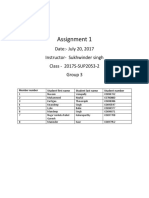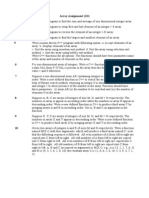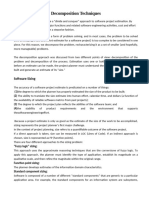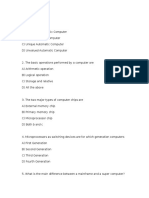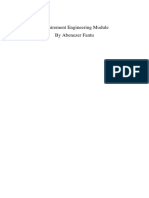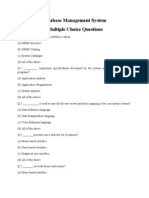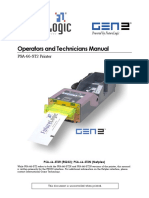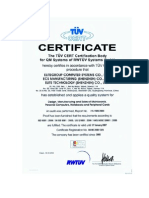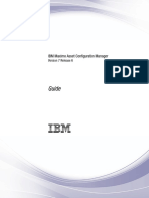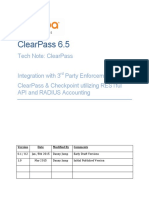Data Structures Through C++: Lab Manual
Uploaded by
ahmadhassan306Copyright:
Available Formats
Data Structures Through C++: Lab Manual
Uploaded by
ahmadhassan306Original Description:
Original Title
Copyright
Available Formats
Share this document
Did you find this document useful?
Is this content inappropriate?
Copyright:
Available Formats
Data Structures Through C++: Lab Manual
Uploaded by
ahmadhassan306Copyright:
Available Formats
Data Structures through C++
Lab Manual
Prepared By:
K. Ravi Chythanya, Assistant Professor, Department of IT
Department of Information Technology
SREE CHAITANYA COLLEGE OF ENGINEERING
L.M.D Colony, Karimnagar-505001
Data Structures through C++ Lab Manual
1) LAB OBJECTIVE
Upon successful completion of this Lab the student will be able to: 1. 2. 3. 4. 5. 6. 7. Know about Object oriented programming. Use Abstract Data Types in the programs. Application of Non recursive functions. OOP principles like Encapsulation Inheritance Polymorphism were frequently used. Trees B and AVL Trees and their operations were used. Different sorting techniques (Quick sort, Merge sort, Heap sort)were used. Hashing Techniques are implemented.
2) Guidelines to Students
Equipment in the lab is meant for the use of student community. Students need to maintain a proper decorum in the computer lab. Students must use the equipment with care. Any damage is punishable. Students are required to carry their observation and records with completed exercises while entering the lab. Students are supposed to occupy the systems allotted to them and are not supposed to talk or make noise in the lab. The seating should be according to roll number wise. Lab can be used in free time/lunch hours by the students who need to use the systems should take prior permission from the lab in-charge. Students (mainly BOYS) are instructed to wear neat formal dress with in-shirt and identity cards should be hanged in their necks (including GIRLS). Lab records need to be submitted on or before date of submission. Students are not supposed to use pen drives in the lab.
K. Ravi Chythanya
-2-
Data Structures through C++ Lab Manual
Algorithm, Flowchart, Program Development
1) Algorithm: An Algorithm is a deterministic procedure that, when followed, yields a definite solution to a problem. An Algorithm is a design or plan of obtaining a solution to the problem. it is logically process of analyzing a mathematical problem and data step by step so as to make it easier to understand and implement solution to the problem .it is composed of a finite set of steps, each of which may require one or more operation. It may have zero or more inputs and produces one or major outputs. it should terminate after a finite number of operations.
Important features of an algorithm:
i. Finiteness: An algorithm terminates after a fixed number of steps. ii. Definiteness: Each step of the algorithm is precisely defined. iii. Effectiveness: All the operations used in the algorithm can be performed exactly in a fixed duration of time. iv. Input: An algorithm has certain precise inputs before the execution of the algorithm begins. v. Output: An algorithm has one or more outputs. 2) Flowchart Flowchart is a graphical representation of an algorithm. It makes use of the basic operations in programming. All symbols are connected among themselves to indicate the flow of information and processing. A Flowchart is a diagrammatic representation of the various steps involved in the solution of a problem. Flowchart is a symbolic diagram of operation sequence, data flow, control flow and processing logic in information processing. The symbols used are simple and easy to learn. 3) Program Development: Step 1: vi example.cpp #include<iostream> using namespace std; class example { public: void ex() { cout<<"This is example program"; } }; void main() { example e; e.ex(); } Step 2: g++ example.cpp (hit Enter) If the program has no errors, then type ./a.out to see the output and the output is as follows. Output: This is example program K. Ravi Chythanya -3-
Data Structures through C++ Lab Manual
Table of Contents
S.No 1 2 3 4 Programs Write a C++ program to implement the following using an array a) Stack ADT b) Queue ADT Write a C++ program to implement the following using a singly linked list a. Stack ADT b. Queue ADT. Write C++ Program to implement the DEQUE (double ended queue) ADT using arrays. Write a C++ program to perform the following operations: a) Insert an element into a binary search tree. b) Delete an element from a binary search tree. c) Search for a key element in a binary search tree. Write a C++ program that use recursive functions to traverse the given binary tree in a) Preorder b) Inorder and c) Postorder Write a C++ program that use non recursive functions to traverse the given binary tree in a) Preorder b) Inorder and c) Postorder Write C++ programs for the implementation of BFS and DFS for a given graph Write C++ programs for implementing the following sorting methods: a) Merge Sort b) Heap Sort. Write a C++ program to perform the following operations. a) Insertion into a B-tree b) Deletion from a B-tree Write a C++ program to perform the following operations. a) Insertion into a AVL-tree b) Deletion from a AVL-tree Write a C++ Program to implement all the functions of Dictionary (ADT) using hashing. Write a C++ Program for implementing Knuth-Moris-Pratt pattern matching algorithm. Page No. 7-15 16-21 22-26
7 8 9 10 11 12
K. Ravi Chythanya
-4-
Data Structures through C++ Lab Manual OOP Concepts: The object oriented paradigm is built on the foundation laid by the structured programming concepts. The fundamental change in OOP is that a program is designed around the data being operated upon rather upon the operations themselves. Data and its functions are encapsulated into a single entity.OOP facilitates creating reusable code that can eventually save a lot of work. A feature called polymorphism permits to create multiple definitions for operators and functions. Another feature called inheritance permits to derive new classes from old ones. OOP introduces many new ideas and involves a different approach to programming than the procedural programming. Benefits of Object-Oriented Programming: Data security is enforced. Inheritance saves time. User defined data types can be easily constructed. Inheritance emphasizes inventions of new data types. Large complexity in the software development can be easily managed. Basic C++ Knowledge: C++ began its life in Bell Labs, where Bjarne Stroustrup developed the language in the early 1980s. C++ is a powerful and flexible programming language. Thus, with minor exceptions, C++ is a superset of the C Programming language. The principal enhancement being the object oriented concept of a class. A Class is a user defined type that encapsulates many important mechanisms. Classes enable programmers to break an application up into small, manageable pieces, or objects. Basic concepts of Object-oriented programming: 1) Object: Objects are the basic run time entities in an object-oriented system. They may represent a person, a place, a bank account, a table of data or any item that the program has to handle. 2) Class: The entire set of data and code of an object can be made of a user defined data type with the help of a class in fact Objects are variables of the type class. Once a class has been defined, we can create any number of objects belonging to that class. A class is thus a collection of objects of similar type. For example: mango, apple, and orange are members of the class fruit. Ex: fruit mango; // will create an object mango belonging to the class fruit. 3) Data Abstraction and Encapsulation: The wrapping up of data and functions in to a single unit is known as encapsulation. Data encapsulation is the most striking feature of a class. The data is not accessible to the outside world and only those functions which are wrapped in the class can access. This insulation of the data from direct access by the program is called data hiding. Abstraction refers to the act of representing essential features without including the background details or explanations. Since the classes use the concept of data abstraction, they are known as Abstraction Data Type (ADT).
K. Ravi Chythanya
-5-
Data Structures through C++ Lab Manual 4) Inheritance: Inheritance is the process by which objects of one class acquire the properties of objects of another class. For example: The bird 'robin ' is a part of the class 'flying bird' which is again a part of the class 'bird'. The concept of inheritance provides the idea of reusability. 5) Polymorphism: Polymorphism is another important OOP concept. Polymorphism means the ability to take more than one form. An operation may exhibit different instances. The process of making an operator to exhibit different behaviors in different instance is known as operator overloading. 6) Dynamic Binding: Binding refers to the linking of a function to the code to be executed in response to the call. Dynamic Binding (also known as late binding) means that the code associated with a given function which is to be used is not known until the time of the call at run-time. A function call associated with a polymorphic reference depends on the dynamic type of that reference. 7) Message Passing: An object-oriented program consists of a set of objects that communicate with each other. This involves the following basic steps: 1. Creating classes that define objects and their behavior. 2. Creating objects from class definitions, and 3. Establishing communication among objects. Objects have a life cycle. They can be created and destroyed. Communication with an object is feasible as long as it is alive.
K. Ravi Chythanya
-6-
Data Structures through C++ Lab Manual 1) Write C++ programs to implement the following data structures using arrays. a) Stack ADT b) Queue ADT Aim: A program to implement the Stack ADT using arrays. STACK: A stack is an ordered collection of data items into which new items may be inserted and from which data items may be deleted at one end. Stack are also called Last-In-First-out (LIFO) lists. Representation of a Stack 8 7 6 5 4 3 2 1 0
TOP
Stack[9] Basic terminology associated with stacks: 1) Stack Pointer (TOP): Keeps track of the current position the stack. 2) Overflow: Occurs when we try to insert (push) more information on a stack than it can hold. 3) Underflow: Occurs when we try to delete (pop) an item off a stack, which is empty. Basic Operation Associated with Stacks: 1) Insert (Push) an item into the stack. 2) Delete (Pop) an item from the stack. a) Algorithm For Inserting an Item into the Stack S: Procedure PUSH(S, SIZE, TOP, ITEM) S Array SIZE Stack size TOP Stack Pointer ITEM value in a cell Step 1: {Check for stack overflow} If TOP==SIZE then Prints(Stack overflow) Return Step 2: {Increment pointer top} TOP=TOP+1 Step 3: {Insert ITEM at top of the Stack} S[TOP]=ITEM K. Ravi Chythanya -7-
F E D C B A
Data Structures through C++ Lab Manual Return b) Algorithm for Deletion of an Item from the Stack S Procedure POP(S, TOP) S Array TOP Stack Pointer Step 1: {Check for stack underflow} If TOP==0 then Prints(Stack underflow) Return Step 2: {Return former top element of stack} ITEM=(S[TOP]); Step 3: {Decrement pointer TOP} TOP=TOP-1 Prints(Deleted item is:,item); Return c) Algorithm to display the items of a Stack S Procedure POP(S, TOP) S Array TOP Stack Pointer Step 1: {Check for stack underflow} If TOP==0 then Prints(stack is empty) Return Step 2: {display stack elements until TOP value} Prints(S[TOP]) TOP=TOP+1 d) Algorithm to display top item of the Stack S Procedure POP(S, TOP) S Array TOP Stack Pointer Step 1: {Check for stack underflow} If TOP=0 then Prints(stack is empty) Return Step 2: {display TOP value into the Stack} Prints(S[TOP])
K. Ravi Chythanya
-8-
Data Structures through C++ Lab Manual
Program:
#include<iostream> using namespace std; #define MAX 10 int top=-1,ch,i; template <class T> class StackADT { public: virtual void Push()=0; virtual void Pop()=0; virtual void Top()=0; virtual void Display()=0; }; template <class T> class Stack: public StackADT<T> { T stk[MAX],ele; public: void Push(); void Pop(); void Top(); void Display(); }; template <class T> void Stack<T>::Push() { if(top==(MAX-1)) cout<<"\nThe stack is full"; else { cout<<"\nEnter an element:"; cin>>ele; top++; stk[top]=ele; cout<<"\nElement pushed successfully\n"; } } template <class T> void Stack<T>::Pop() K. Ravi Chythanya -9-
Data Structures through C++ Lab Manual { if(top==-1) cout<<"\nThe stack is empty"; else { ele=stk[top]; top--; cout<<"The deleted element is:"<<ele; } } template <class T> void Stack<T>::Top() { if(top==-1) cout<<"\nThe stack is empty"; else cout<<"The top element of the stack is:"<<stk[top]; } template<class T> void Stack<T>::Display() { if(top==-1) cout<<"\nThe stack is empty"; else { cout<<"\nThe elements in the stack are:"; for(i=top;i>=0;i--) cout<<"\n"<<stk[i]; } } int main() { Stack<int> s1; do { cout<<"\n****MENU****"; cout<<"\n1. Push\n2. Pop\n3. Top\n4. Display\n5. Exit"; cout<<"\nEnter ur Choice:"; cin>>ch; switch(ch) K. Ravi Chythanya - 10 -
Data Structures through C++ Lab Manual { case 1: s1.Push(); break; case 2: s1.Pop(); break; case 3: s1.Top(); break; case 4: s1.Display(); break; case 5: exit(1); default: cout<<"Enter correct Choice"; } }while(true); }
K. Ravi Chythanya
- 11 -
Data Structures through C++ Lab Manual
Aim: A C++ program to implement the Queue ADT using arrays. QUEUE:
Queue is an ordered collection of data such that the data is inserted at one end and deleted from other end. It is a collection of items to be processed on a First-In-First-Out(FIFO) or First Come First Served(FCFS) basics. Ascending order of memory Deletion A B C D E F G insertion
Front
Rear
Basic Operation Associated on Queues: 1) Insert an item into the Queue. 2) Delete an item into the Queue. a) Algorithm to insert an item into a Queue Q: Procudure Insert(Q, SIZE, F, R, ITEM) Q Array SIZE Queue size F front Pointer R rear pointer ITEM: information to be inserted at the rear of queue. Step 1: {Check for Queue overflow} If R>=SIZE then Prints(Queue overflow) Return Step 2: {Increment rear pointer} R=R+1 Step 3: {Insert new element at rear end of queue} Q[R]=ITEM Step 4: {If initially the queue is empty adjust the front pointer} If F=0, then F=1 b) Algorithm to delete an item from a Queue Q: Procedure Delete(Q, F, R) Q Array F front Pointer R rear pointer ITEM: information to be inserted at the rear of queue. Step 1: {Check for Queue underflow} If F=0 then K. Ravi Chythanya - 12 -
Data Structures through C++ Lab Manual Prints(Queue underflow) Return Step 2: {Delete the queue element at front end and store it into item} ITEM=Q[F] Step 3: {If queue is empty after deletion,set front and rear pointers to 0} If F=R then F=0 R=0 {Otherwise increment front pointer} Else F=F+1 Return(ITEM) c) Algorithm to display the items from the Queue Q Procedure Dispaly(Q) Q Array Step1: {Check queue values} If F<0 Prints(Queue is empty) Step 2: {display Queue values} For I value F to R Prints(Q[I]) I=I+1
Program:
#include<iostream> using namespace std; #define MAX 10 int front=0,rear=0,ch,i; template <class T> class QueueADT { public: virtual void Insert()=0; virtual void Delete()=0; virtual void Display()=0; }; template <class T> class Queue: public QueueADT<T> { T q[MAX],ele; public: K. Ravi Chythanya - 13 -
Data Structures through C++ Lab Manual void Insert() { if(rear==MAX) cout<<"\nQueue is full"; else { cout<<"\nEnter an element:"; cin>>ele; q[rear]=ele; rear++; cout<<"\nElement inserted successfully\n"; } } void Delete() { if(front==rear) cout<<"\nQueue is empty"; else { ele=q[front]; front++; cout<<"The deleted element is:"<<ele; } } void Display() { if(front==rear) cout<<"\nQueue is empty"; else { cout<<"\nThe elements in the queue are:"; for(i=front;i<rear;i++) cout<<q[i]<<" "; } } }; int main() { Queue<int> q1; do K. Ravi Chythanya - 14 -
Data Structures through C++ Lab Manual { cout<<"\n***MENU***"; cout<<"\n1. Insert\n2. Delete\n3. Display\n4. Exit"; cout<<"\nEnter ur Choice:"; cin>>ch; switch(ch) { case 1: q1.Insert(); break; case 2: q1.Delete(); break; case 3: q1.Display(); break; case 4: exit(1); default: cout<<Entered Wrong Choice; } }while(1); }
K. Ravi Chythanya
- 15 -
Data Structures through C++ Lab Manual 2) Write C++ programs to implement the following data structures using a singly linked list. a) Stack ADT b) Queue ADT
Aim: A C++ program to implement the Stack ADT using singly linked list. Program:
#include<iostream> using namespace std; template<class t> class node { public: t info; node *link; }; template <class t> class StackADT { virtual void Push()=0; virtual void Pop()=0; virtual void Top()=0; virtual void Display()=0; }; template<class t> class StackLinkImp:public StackADT<t> { public: t item; node<t> *temp, *top; StackLinkImp() { top=NULL; } void Push() { temp=new node<t>; cout<<"Enter the itemto be insrted on to the stack:"; cin>>item; if(top==NULL) temp->link=NULL; else K. Ravi Chythanya - 16 -
Data Structures through C++ Lab Manual temp->link=top; temp->info=item; top=temp; cout<<"Insertion Completed Successfully"; } void Pop() { if(top==NULL) cout<<"Stack is empty"; else { item=top->info; top=top->link; cout<<"The deleted element is:"<<item; } } void Top() { if(top==NULL) cout<<"Stack is empty"; else cout<<"The top element is:"<<top->info; } void Display() { if(top==NULL) cout<<"Stack is empty"; else { temp=top; cout<<"The elements in the stack are:"; while(temp!=NULL) { cout<<temp->info<<" "; temp=temp->link; } } } }; int main() K. Ravi Chythanya - 17 -
Data Structures through C++ Lab Manual { int ch; StackLinkImp<int> s1; do { cout<<"\n****Menu****"; cout<<"\n1. Push\n2. Pop\n3. Top\n4. Display\n5. Exit"; cout<<"\nEnter ur choice:"; cin>>ch; switch(ch) { case 1: s1.Push(); break; case 2: s1.Pop(); break; case 3: s1.Top(); break; case 4: s1.Display(); break; case 5: exit(1); default: cout<<Entered Wrong Choice; } }while(1); }
K. Ravi Chythanya
- 18 -
Data Structures through C++ Lab Manual
Aim: A C++ program to implement the Queue ADT using singly linked list. Program:
#include<iostream> using namespace std; template<class t> class node { public: t info; node *link; }; template<class t> class QueueADT { virtual void Insert()=0; virtual void Delete()=0; virtual void Display()=0; }; template <class t> class QueueLinkImp: public QueueADT<t> { public: t item; node<t> *temp,*front,*rear; QueueLinkImp() { front=rear=NULL; } void Insert() { temp=new node<t>; cout<<"Enter an element to be inserted in to queue:"; cin>>item; temp->info=item; temp->link=NULL; if(front==NULL) { front=rear=temp; cout<<item<<" inserted Successfully"; return; K. Ravi Chythanya - 19 -
Data Structures through C++ Lab Manual } rear->link=temp; rear=rear->link; cout<<item<<" inserted Successfully"; } void Delete() { if(front==NULL) cout<<"Queue is empty"; else { item=front->info; front=front->link; cout<<"Deleted Element is: "<<item; } } void Display() { if(front==NULL) cout<<"Queue is empty"; else { cout<<"The elements in the queue are:"; for(temp=front;temp!=NULL;temp=temp->link) cout<<temp->info<<" "; } } }; void main() { int ch; QueueLinkImp<int> q1; do { cout<<"\n****MENU****"; cout<<"\n1. Insert\n2. Delete\n3. Display\n4. Exit"; cout<<"\nEnter ur choice:"; cin>>ch; switch(ch) { K. Ravi Chythanya - 20 -
Data Structures through C++ Lab Manual case 1: q1.Insert(); break; case 2: q1.Delete(); break; case 3: q1.Display(); break; case 4: exit(1); default: cout<<Entered Wrong Choice; } }while(1); }
K. Ravi Chythanya
- 21 -
Data Structures through C++ Lab Manual 3) Write C++ programs to implement the Double Ended Queue (DEQUE) using array.
Aim: A C++ program to implement the Double Ended Queue (DEQUE) using array. Program:
#include <iostream> using namespace std; #define MAX 10 int front=-1,rear=-1,c,i; template<class t> class dqueADT { public: virtual void addqatbeg()=0; virtual void addqatend()=0; virtual void delqatbeg()=0; virtual void delqatend()=0; virtual void display()=0; }; template <class t> class dque: public dqueADT<t> { public: t q[MAX],item; dque() { front=rear=-1; for(i=0;i<MAX;i++) q[i]=0; } void addqatbeg() { cout<<"Enter an element:"; cin>>item; if (front==0&&rear==MAX-1) { cout<<"\nDeque is full"<<endl; return ; } if(front==-1) { K. Ravi Chythanya - 22 -
Data Structures through C++ Lab Manual front=rear=0; q[front]=item; return; } if(rear!=MAX-1) { c=count(); int k=rear+1; for(i=1;i<=c;i++) { q[k]=q[k-1]; k--; } q[k]=item; front=k; rear++; } else { front--; q[front]=item; } } void addqatend() { cout<<"Enter an element:"; cin>>item; if(front==0&&rear==MAX-1) { cout<<"\nDeque is full"<<endl; return; } if(front==-1) { rear=front=0; q[rear]=item; return; } if(rear==MAX-1) { K. Ravi Chythanya - 23 -
Data Structures through C++ Lab Manual int k=front-1; for(i=front-1;i<rear;i++) { k=i; if(k==MAX-1) q[k]=0; else q[k]=q[i+1]; } rear--; front--; } rear++; q[rear]=item; } void delqatbeg() { if(front==-1) { cout<<"\nDeque is empty"<<endl; return; } item=q[front]; q[front]=0; if(front==rear) front=rear=-1; else front++; cout<<"Deleted item is:"<<item; } void delqatend() { if(front==-1) { cout<<"\nDeque is empty"<<endl; return; } item=q[rear]; q[rear]=0; rear--; K. Ravi Chythanya - 24 -
Data Structures through C++ Lab Manual if(rear==-1) front=-1; cout<<"Deleted item is: "<<item; } void display() { cout<<endl<<"front-> "; for(i=0;i<MAX;i++) cout<<" "<<q[i]; cout<<" <-rear"; } int count() { int c=0; for(i=0;i<MAX;i++) { if(q[i]!=0) c++; } return c; } }; main() { int ch; dque<int> s1; do { cout<<"\n****Menu****"; cout<<"\n1. Insert at Beginning\n2. Insert at End\n3. Delete from Beginning\n4. Delete from End\n5. Display\n6. Exit"; cout<<"\nEnter ur choice:"; cin>>ch; switch(ch) { case 1: s1.addqatbeg(); break; case 2: s1.addqatend(); break; case 3: s1.delqatbeg(); K. Ravi Chythanya - 25 -
Data Structures through C++ Lab Manual break; case 4: s1.delqatend(); break; case 5: s1.display(); break; case 6: exit(1); } }while(1); }
K. Ravi Chythanya
- 26 -
You might also like
- Lecture Note Formal Methods in Software Engineering - Lecture 1 (Download Tai Tailieutuoi - Com)No ratings yetLecture Note Formal Methods in Software Engineering - Lecture 1 (Download Tai Tailieutuoi - Com)6 pages
- Assignment 1: Date:-July 20, 2017 Instructor - Sukhwinder Singh Class - 2017S-SUP2053-2 Group 3No ratings yetAssignment 1: Date:-July 20, 2017 Instructor - Sukhwinder Singh Class - 2017S-SUP2053-2 Group 35 pages
- Chapter 2 - Requirements Engineering ProcessNo ratings yetChapter 2 - Requirements Engineering Process57 pages
- SRE - Week - 5 - Requirement Elicitation ProcessNo ratings yetSRE - Week - 5 - Requirement Elicitation Process32 pages
- Pressman CH 23 Estimation For Software Projects 2No ratings yetPressman CH 23 Estimation For Software Projects 237 pages
- AI Based Healthcare Chatbot System Using Natural Language ProcessingNo ratings yetAI Based Healthcare Chatbot System Using Natural Language Processing5 pages
- SE CH - 3 Software Requirement EngineeringNo ratings yetSE CH - 3 Software Requirement Engineering4 pages
- Multi Modal Hate Speech Detection Using Machine Learning100% (1)Multi Modal Hate Speech Detection Using Machine Learning5 pages
- Formal Methods in Software Engineering: Bilal KhanNo ratings yetFormal Methods in Software Engineering: Bilal Khan43 pages
- (Chapter 1 Introduction) : The Evolving Role of SoftwareNo ratings yet(Chapter 1 Introduction) : The Evolving Role of Software16 pages
- Sad Lec22 - Notes - Cocomo, Cmmi and Case ToolNo ratings yetSad Lec22 - Notes - Cocomo, Cmmi and Case Tool35 pages
- Unit - Iv Software Quality Planning & ControlNo ratings yetUnit - Iv Software Quality Planning & Control11 pages
- Database Management System Multiple Choice QuestionsNo ratings yetDatabase Management System Multiple Choice Questions7 pages
- Data Governance for Tax Administrations: A Practical GuideFrom EverandData Governance for Tax Administrations: A Practical GuideNo ratings yet
- Computer security incident management Standard RequirementsFrom EverandComputer security incident management Standard RequirementsNo ratings yet
- SOLVED System and Network Administration CIT-505 - BS IT (5th Semester) Session 2020-2024 GCUF Mid Term ExaminationNo ratings yetSOLVED System and Network Administration CIT-505 - BS IT (5th Semester) Session 2020-2024 GCUF Mid Term Examination3 pages
- ThinkCentre M70 Tiny Basic SpecificationsNo ratings yetThinkCentre M70 Tiny Basic Specifications1 page
- Cielo Networks SkyLink CGX Datasheet - No FEC OperationNo ratings yetCielo Networks SkyLink CGX Datasheet - No FEC Operation2 pages
- Feature Test Scenario Steps Login To Flipkart Validate Login PageNo ratings yetFeature Test Scenario Steps Login To Flipkart Validate Login Page16 pages
- BS - P2M - 001 - Equipment Maintenance - InternalNo ratings yetBS - P2M - 001 - Equipment Maintenance - Internal3 pages
- 4G3 ATN910i Commissioning Guide-20141123No ratings yet4G3 ATN910i Commissioning Guide-2014112319 pages
- Android: Application Framework Dalvik Virtual Machine Integrated BrowserNo ratings yetAndroid: Application Framework Dalvik Virtual Machine Integrated Browser41 pages
- Guide: IBM Maximo Asset Configuration ManagerNo ratings yetGuide: IBM Maximo Asset Configuration Manager140 pages
- Industry Canada Presentation On Spam LawNo ratings yetIndustry Canada Presentation On Spam Law38 pages
- SEO: The PAGE RANK Algorithm: Presidency University, Bengaluru School of EngineeringNo ratings yetSEO: The PAGE RANK Algorithm: Presidency University, Bengaluru School of Engineering56 pages
- CPPM TechNote - 3rd Party Enforcement Points (CheckPoint) v1No ratings yetCPPM TechNote - 3rd Party Enforcement Points (CheckPoint) v132 pages
- Lecture Note Formal Methods in Software Engineering - Lecture 1 (Download Tai Tailieutuoi - Com)Lecture Note Formal Methods in Software Engineering - Lecture 1 (Download Tai Tailieutuoi - Com)
- Assignment 1: Date:-July 20, 2017 Instructor - Sukhwinder Singh Class - 2017S-SUP2053-2 Group 3Assignment 1: Date:-July 20, 2017 Instructor - Sukhwinder Singh Class - 2017S-SUP2053-2 Group 3
- AI Based Healthcare Chatbot System Using Natural Language ProcessingAI Based Healthcare Chatbot System Using Natural Language Processing
- Multi Modal Hate Speech Detection Using Machine LearningMulti Modal Hate Speech Detection Using Machine Learning
- Formal Methods in Software Engineering: Bilal KhanFormal Methods in Software Engineering: Bilal Khan
- (Chapter 1 Introduction) : The Evolving Role of Software(Chapter 1 Introduction) : The Evolving Role of Software
- Database Management System Multiple Choice QuestionsDatabase Management System Multiple Choice Questions
- Introduction to Linux: Installation and ProgrammingFrom EverandIntroduction to Linux: Installation and Programming
- Data Governance for Tax Administrations: A Practical GuideFrom EverandData Governance for Tax Administrations: A Practical Guide
- Computer security incident management Standard RequirementsFrom EverandComputer security incident management Standard Requirements
- SOLVED System and Network Administration CIT-505 - BS IT (5th Semester) Session 2020-2024 GCUF Mid Term ExaminationSOLVED System and Network Administration CIT-505 - BS IT (5th Semester) Session 2020-2024 GCUF Mid Term Examination
- Cielo Networks SkyLink CGX Datasheet - No FEC OperationCielo Networks SkyLink CGX Datasheet - No FEC Operation
- Feature Test Scenario Steps Login To Flipkart Validate Login PageFeature Test Scenario Steps Login To Flipkart Validate Login Page
- Android: Application Framework Dalvik Virtual Machine Integrated BrowserAndroid: Application Framework Dalvik Virtual Machine Integrated Browser
- SEO: The PAGE RANK Algorithm: Presidency University, Bengaluru School of EngineeringSEO: The PAGE RANK Algorithm: Presidency University, Bengaluru School of Engineering
- CPPM TechNote - 3rd Party Enforcement Points (CheckPoint) v1CPPM TechNote - 3rd Party Enforcement Points (CheckPoint) v1








